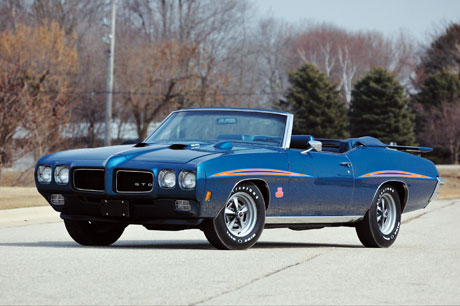SCM Analysis
Detailing
| Vehicle: | 1970 Pontiac GTO Judge Ram Air IV |
| Original List Price: | 1969, $3,940; 1970, $4,054 |
| Tune Up Cost: | $150 |
| Distributor Caps: | $18 |
| Club Info: | GTO Association of America PO Box 213 Timnath, CO 80547 |
| Website: | http://www.gtoaa.org |
| Investment Grade: | B |
This car sold for $371,000, including buyer’s premium, at Mecum’s Fall High Performance Auction in St. Charles, Illinois, on October 3, 2009.
The hell, you say, muscle car prices are in the toilet-this result must surely be a typo. And a Pontiac, of all cars. We all know they are the value-priced alternative to elephant-motored Mopars and big-block Chevys, right? Not so fast, buckaroo.
The sale of this Pontiac GTO Ram Air IV Judge, hot on the heels of the highly publicized sale by RM Auctions of the Ray Allen 1970 Chevelle LS6 convertible for $264,000 on September 26 (profiled in January, p. 46), offers an interesting comparison. How on earth could a GTO with no race history sell for over $100k more than one of the most famous drag cars of all time, and one that previously sold for $1.15m? Let’s dissect it.
Production numbers: Not much to go on here. Both are incredibly low-production cars, with 17 Ram Air IV Judge convertibles documented via factory records, and (by most experts’ opinion) 16 LS6 convertibles produced.
Street cred: Both are the top engines available from their respective divisions, although the LS6 with 450 (advertised) horsepower trumped the 370 advertised hp of the round-port Ram Air IV GTO. This carried over to the street, as the LS6 was clearly the better performer and they tended to hold their guts within the confines of their engine blocks much longer than the somewhat rpm-sensitive RAIV.
Price trends in recent years: Both LS6 and RAIV Judge convertibles are scarce enough to make tracking prices difficult at best, but, as someone who has been involved with multiple sales of both, I can offer some insight. The highest price paid for a 1970 RAIV Judge convertible was around $500k, although two examples had much higher offers rejected by their owners. A few real LS6 convertibles have traded in the same range, roughly $500k-$700k, with the Ray Allen car being the record holder at $1.15m in 2006. A very interesting comparison for the Judge was the May 2008 sale by Mecum of another 1970 RAIV Judge convertible, a restored 4-speed example in silver lacking its original engine, at $378k, almost an identical result to this October 2009 sale.
Where the devil resides
But alas, the devil is in the details. The $371k Mecum-sold RAIV convertible had something very few of these big-horsepower, low-production cars usually do-its original engine, solid owner history, and original documentation. Although equipped with a Turbo 400 automatic transmission rather than the more desirable (and much more valuable) M21 Muncie 4-speed, it is likely this transmission that saved the original motor-either because a more “mature” original owner bought the car to drive rather than race, or it prevented missed shifts and the resultant, and often fatal, connecting rod breakatosis that sidelined many a Ram Air Pontiac.
Other positives include the highly desirable Atoll Blue exterior, which automatically came with the wild blue-orange-pink Judge stripes. Add the blue interior and we have the second best option you can have on a muscle car: “eyeball.” Remember, the late 1960s and early 1970s were home to far too many color-challenged cars. Think green and brown, kinda like the home appliances that were so popular at the time.
Today, most collectors have refined their tastes to the point that they want a car that looks as good as it drives, as most look at their cars far more than they drive them. Which is why, in instances such as this with miniscule production numbers, some buyers are happy to forego a 4-speed car in return for a numbers-matching automatic car they actually like to look at.
Another important difference between the Chevrolet and Pontiac camps is that of verifiable production numbers. Thanks to Jim Mattison and Pontiac Historic Services (PHS), we know exactly how many GTOs were produced in every possible combination. Armed with a serial number and $45, one can fax PHS and within a few hours get copies of the actual factory build order for that very car to see if it is what it purports to be.
Paperwork makes the difference
This availability of factory records is perhaps the biggest reason behind today’s strong Pontiac values. Compare this to 1970 LS6 Chevelle convertibles and one can see the logic. Through the process of elimination and tracking known LS6 cars, production numbers are merely estimates, deemed reliable but not guaranteed. This clearly tempers buyers’ willingness to pay huge prices for a “one of 16” car that could later prove to be a “one of 40” car. Not to mention that with no factory records available, it is often impossible to verify an LS6 4-speed car wasn’t born as a 327 2-barrel car with a Powerglide.
Knowing all this, I think our 1970 Pontiac GTO Judge Ram Air IV Convertible was a solid buy. It is a known quantity, one of 17 produced, with its original Protect-O-Plate, great color combo, and its original drivetrain. Adding to this, the May 2008 sale of a similar car at the same price speaks of market stability for RAIV Judge convertibles-even in this catch-the-falling-knife market-and I call this a spot-on result for both buyer and seller. Had this car had three pedals, my hand would have been in the air. What can I say; I don’t know how to drive automatics. Well done.
